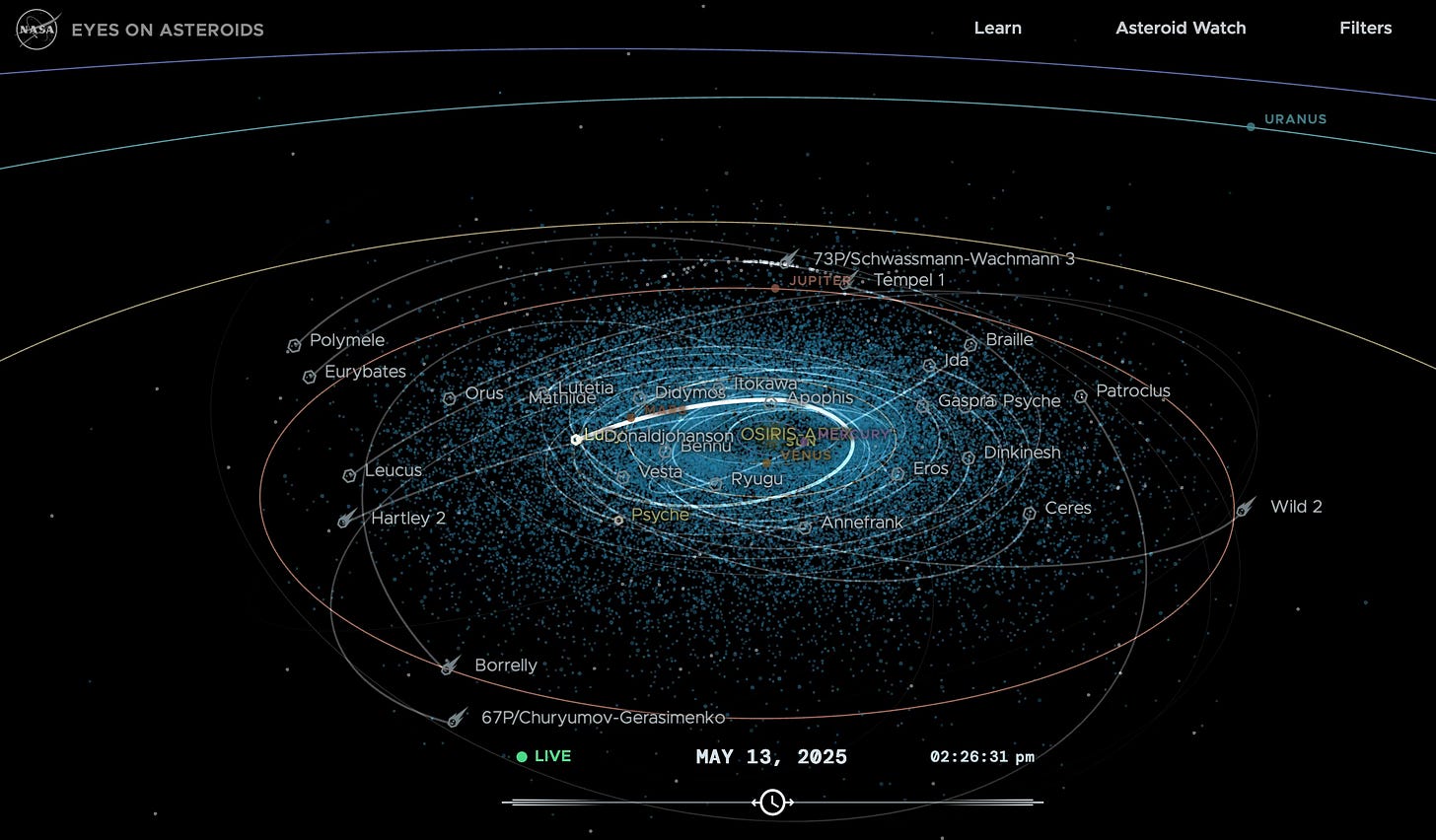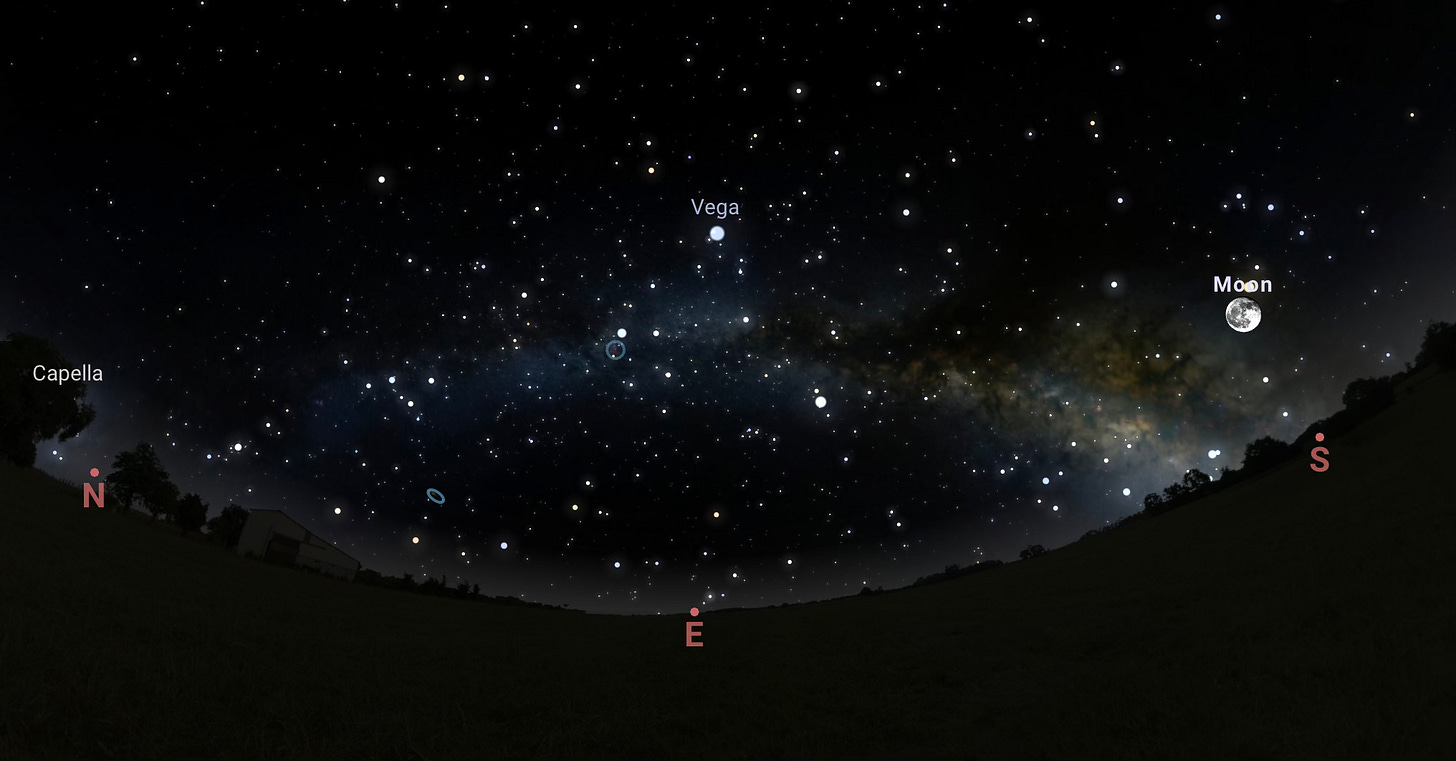Our Corner of the Known Universe
A brief tour of the local cosmos will set the stage for future discussions.
Hey Friends!
This is the second in our series of essays based on our recent talk about the Cosmic Microwave Background at Ryzo Wines for the Methow Valley Dark Skies Week. Our aim in these essays is to expand upon what we talked about, and answer the questions we were asked along the way.
Today we’ll focus on our own corner of the universe, from the Solar System to our Milky Way Galaxy. Next time, we’ll zoom out just a bit further. The idea is to give you a sense of scale for both the size of the known Universe and depth of that knowledge.
Sean
The Solar System
The light from the Sun - our nearest star - takes about 8 minutes to reach us on Earth. Light moves really quickly, well over 670 million miles per hour, so 8 minutes means the sun is pretty far away.
NASA has a great website that shows us the real-time location of all known planets and asteroids in our solar system. They also include most major NASA satellite experiments.

Neptune : 4 light-hours
The furthest major planet from the Sun is Neptune. Using NASA’s Eyes, you can see directly how Neptune is 30 times further away from the sun than we are. It takes sunlight over 4 hours to reach Neptune, and the sun itself would shine 900 times less brightly. It would also appear considerably smaller1.
Of course, there is more to our solar system than the planets.
The Kuiper Belt : 7 light-hours
These are the other objects gravitationally bound to the sun. There are plenty of icy, rocky things that are small when compared with planets. These famously include the dwarf planet Pluto, and others of comparable size: Eris, Haumea and Makemake2.
The Kuiper Belt consists of host of objects, between minor planets, rocks and other chunks of ice ranging from the orbit of Neptune to about twice that distance. It’s essentially a second belt of asteroids3. It takes about 7 hours for sunlight to reach the outer objects of the Kuiper Belt.
The Heliopause : 17 light-hours
It’s hard to bound the size of the Solar System exactly, but one reasonable line to draw is where the Sun’s radiation becomes weaker than the radiation and material that fills up the space between stars. This is a bit like trying to draw a boundary between a creek and the river it flows into.
This approximate boundary is called the Heliopause. It takes light about 17 hours to go from the sun to the Heliopause.4
There may well be other objects beyond the Kuiper Belt. Such objects would barely feel the Sun’s gravitational pull, and would probably also be subject to those of other stars and big objects nearby. Arguably, this is where many comets originate. A model for this kind of collection of loosely bound debris is called the Oort Cloud, which hypothetically could extend out as far as light year from the Sun.
The Milky Way
One feature of the dark skies we enjoy in the Methow Valley is the almost nightly appearance of Milky Way. It’s a faint glow that stretches across the night sky. This glow comes from a collection of stars, dust and other radiation which together makes up our home Galaxy.

Even while bound together, stars in our home galaxy are quite far from us. Light from the nearest, neighboring star, Proxima Centauri, takes about 4 years and 3 months to get to our telescopes5.
Our Sun is but one star of the hundreds of billions of others bound together to form the Milky Way Galaxy. Light from our sun could take over 50,000 years to reach distant parts of our galaxy.
The distance that light can travel in one year is a bit under 6 trillion miles. We call that distance a light year. With this unit of measurement, the Milky Way is 105,000 light years in diameter, but only about 1000 light years thick.
Like planets orbiting the Sun6, the stars in the Milky Way orbit the galactic core - a huge bulge made up of clusters of tightly bound stars, gas and of course, a supermassive black hole.
Two Great Questions
What determines the extent of a galaxy?
What a great and nuanced question! There is a short and a long answer to this.
The short is easy enough to state:
“A galaxy is a system of stars and other material components such as dark matter7, gas, and dust that is gravitationally bound, and usually separated from its neighbors by hundreds of thousands of light years. Galaxies come in various different shapes and sizes. The smallest galaxies can have a few thousand stars, while the largest can have tens of trillions. ‘The Galaxy’ or ‘Galaxy’ with a capital letter usually refers to our home galaxy, the Milky Way, which has around 100–400 billion stars.”
Office of Education for the International Astronomical Union.
This may seem somewhat imprecise. There is no precise definition adopted collectively by the International Astronomical Union, rather, it is descriptive.
The long answer involves explaining why this definition is so vague. Here are a couple of cases studies that would warrant this approach.
First, imagine that two comparable sized galaxies approach each other and collide. The endpoint of such a collision is almost certainly a single galaxy. At what point do we go from two galaxies to a single one? If the two galaxies collided with each other - thanks to a mutual, gravitational attraction, does that mean they were both originally bound together? If so, how could we have then considered them two, independent galaxies?8
Second, imagine two galaxies of vastly different size. For example, the Milky Way some satellite, “dwarf” galaxies. Notably these include the Large and Small Magellanic clouds9. These objects are gravitationally bound and compact in their own right, but they are also gravitationally bound to the Milky Way. Given this structure, hopefully it is clear they should be viewed as separate objects.
A bit later we shall discuss more details of those galaxies that are near to our own.
Why are objects like galaxies and our solar system flat?
Not all galaxies are flat. Some are giant blobs10 of stars and clusters of stars. It is true that many galaxies do find themselves evolving into a spiral structure, with distinct arms and a planar geometry.
Our Milky Way galaxy is a spiral galaxy.
Does a collapsing mass of dust and stars need to be start out in a flat shape to form a spiral galaxy? No. Most any random collection of material out in space will eventually form a flat disk. This is the result of gravitational force and the conservation of angular momentum11.
The spiral arms of a galaxy like our Milky Way form in the later stages of this process.
This is also the basic reason why our solar system is essentially planar. It formed as a flat disk, and the planets formed from within that disk.
But if that is true, where do the elliptical and irregular galaxies come from? In all likelihood, they have a more complicated history12. Galaxies occasionally collide. Such collisions would lead to a dynamic rearrangement that could lead to less structured appearance13.
As with almost everything is Galactic Astronomy and Cosmology, our understanding is based on statistical observations. We see billions of other galaxies at different states of their evolution. We simply cannot directly observe the direct formation of galaxies because it’s taken the age of the universe for most of them to get to their present state. Nobody has been around - let alone alive - for that long.
However, we have a pretty strong grasp on the basic physics involved. Simulations can be done using our knowledge of gravitation. Even amateur simulations14 with smaller numbers of particles can produce the same results.
All of these facts are just different ways to interpret the same data: the sun is 30 times further away. Mathematically, the brightness of a light source tends to falls off by the square of the distance.
Many planetary objects have classical names, like the Jupiter and Mars. Some objects, like Haumea, have been given Hawaiian names. This is deliberate and related to the sheer volume of research done by the telescopes on the summit of Mauna Kea. There is much to say about that, as this research is not without controversy. I’ve written about this issue before, and it honestly surprising and exacerbating to see how resistant the professional academics were to taking this issue seriously, despite believing that they actually were.
The “famous” asteroid belt is a collection of rocky matter between the orbits of Mars and Jupiter. Like the Kuiper Belt, the asteroid belt also includes objects that you might also call planets, like Ceres.
NASA has a great video explanation of this phenomena.
Proxima is just a bit too faint to be seen without a telescope. Partially this is because it is far away, but mostly it’s because the star itself is so small.
The orbits of the planets follow Newtonian mechanics rather well. That stars in our galaxies, apparently less so. Of course, we also don’t have as great an understanding of what else exists inside our galaxy, compared with our knowledge of the solar system. There is strong reason to believe that there’s a large amount of matter that doesn’t shine like stars, which influences the rotational dynamics of the stars in galaxies. This, combined with a host of other, independent observations, strongly suggests that there is a new kind of particulate matter in our universe that just doesn’t interact with the electromagnetic field.
I tried my best to completely avoid the discussion of Dark Matter in this talk. That’s a wild topic of which we known an enormous amount, but all of it indirectly. We’ll save that for another time.
This is a pedantic question that you should not take seriously. Lawyers aren’t needed to maintain the integrity of Astronomical taxonomy. That said, you might also now reflect on the idea of a Heliopause mentioned earlier.
These can be seen as diffuse light patches in dark, night skies of the Southern Hemisphere.
A less prosaic term might be elliptical or ellipsoidal.
I am sweeping a physics lesson under the rug here. Largely on purpose. The study of angular momentum is both fascinating and not terribly challenging, but it is technical. Given virtually any starting point, a galaxy will form as a flat disk, but there’s no telling where the axis of that disk is going to point. That value is essentially random, and depends both on the initial distribution of matter and how it evolved. This is why images that contain many galaxies, like the Hubble Deep Field, have them essentially pointing in all kinds of random directions.
Could it be that elliptical galaxies are just too young to have formed a flat disk? Statistically not, as many of the stars seen in elliptical galaxies appear to be much older than those found in a typical spiral galaxy. Although recent studies suggest that this might be merely a statistical bias based on observation, rather than representative of a causal effect.
Of course, give things another few billion years to evolve and we may well begin to see those structures start to flatten. But even that is nuanced! Elliptical galaxies appear to have their own inner workings - including the distribution of velocities of their constituent stars - that resist flattening.
Evidently, this fellow Max has a GitHub account where you can check out the code for yourself. It’s based on the Barnes-Hut N-body algorithm.



